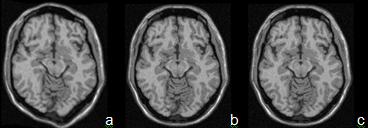Image Registration
• Thin-plate spline (TPS) deformable image registration
• B-spline deformable image registration
We implemented mutual information B-spline deformation registration algorithms. Mutual information does not assume a linear intensity relationship between images and has been used for registration of images of either the same modality or different modalities. A motion constraint is optimized in order to achieve a smooth function instead of an unrealistic result. A gradient-based minimization method is used to find the B-splines control coefficients for optimal transformation. Multiresolution strategy is applied to register the image from the downsampled low-resolution image to the original high-resolution images. The number of control points also hierarchally increase along the multiresolution framework. The deformation computed at low resolution is the initial transformation for the optimization at the high resolution.

Figure 2. Deformable registration of 3D brain MR data. With deformable transformation, Image (a) is transformed into Image (b) with shape deformation in order to match the reference image (c).
• Finite element model-based deformable registration• Two-dimensional (2D) image registration software
• Three-dimensinal (3D) image registration software
• 3D to 2D Registration
• Slice to Volume Registration
Image Classification
Image Segmentation
Attenuation Correction
Partial Volume Correction
Motion Correction
